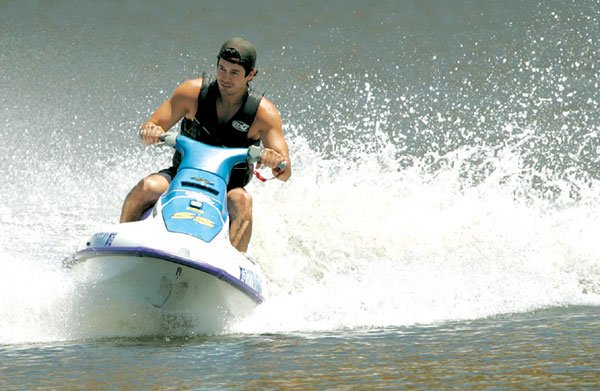GILROY
– After a six-year ban, Anderson and Calero reservoirs will
welcome personal watercraft beginning Aug. 16, but with
restrictions.
GILROY – After a six-year ban, Anderson and Calero reservoirs will welcome personal watercraft beginning Aug. 16, but with restrictions.
The Santa Clara Valley Water District and Santa Clara County’s Parks and Recreation Department have decided to reopen the lakes to personal watercraft (PWC), but only one kind of PWC will be allowed per six surface acres of water, said district spokesperson Mike DiMarco.
Personal watercraft are motorized boats more commonly known as Jet Skis, Sea Doos and Wave Runners.
Roughly 170 personal watercraft per day will be allowed on Anderson Reservoir, the county’s largest reservoir. Roughly 70 per day will be allowed on Calero Reservoir, northwest of Morgan Hill. This is assuming the water level is at capacity,
DiMarco said, and those numbers will drop if the lakes dip below full capacity.
There will be no restrictions at Coyote Reservoir, east of San Martin, because that lake is not directly connected to a water treatment plant as are Anderson and Calero reservoirs, DiMarco said.
The water district’s decision to ban the watercraft in 1998 stemmed from national research that showed the potential cancer-causing effects of methyl tertiary butyl ether (MTBE), an octane-boosting
chemical in gasoline used in personal watercraft engines at the time. The engines of personal watercraft deposited more gas, therefore more MTBE, in the water than other boat engines.
Manufacturers, however, have since devised ways to build cleaner-burning engines. Additionally, the state this year initiated a prohibition of MTBE in California’s gasoline supplies.
The water district, which manages the reservoirs, and the parks and recreation department, which manages the surrounding park land, held public meetings in May, June and July to gather public comment on the issue. Although personal watercraft enthusiasts supported the lakes’ reopening, a handful of residents who live near the reservoirs contested because of watercraft noise and increased traffic.
Probably the most organized dissent came from the Bluewater Network, a San Francisco-based environmental group that sent nearly 600 letters to the county from California residents. The letters pressed concerns about wildlife, personal safety and air and water quality should personal watercraft be allowed back on the lakes.
Sean Smith, public lands director for the Bluewater Network, received the news of the county’s decision with regret.
“I think the county has made a tragic mistake,” Smith said. “Sadly, the public and the environment will pay the price. We presented the county with evidence that these watercrafts are dumping pollutants in the water, and they know it. I don’t know where or how they are looking at that evidence, but it’s there.”
Smith cited public safety as the primary threat posed by personal watercraft. While other state and national lakes are continuing to prohibit personal watercraft due to safety concerns, Santa Clara County is regressing in their regulations, Smith said.
DiMarco said the county met with Bluewater Network staff to discuss the issue.
“We respect their concerns, but we don’t see evidence at our reservoirs of their affairs,” he said. “This is a great thing for people who enjoy these activities, and we’ve received a great amount of support and enthusiasm.”
DiMarco said the water district will continue to check reservoir water for gasoline and implement additional restrictions if necessary.
Weekday launches will be granted on a first-come, first-served basis. Weekend launches require reservations through Santa Clara County Parks and Recreation Department, which can be reached at 355-2201 from 8:30 a.m. to 3:30 p.m. Monday through Friday or at www.parkhere.org.















